Capital:
Wellington
Currency
New Zealand dollar
Best time to visit:
For the outdoors, the best months are the hottest ones, ie from November to April. From June to August you can ski! In general, it is colder in the south than in the north and it rains more in the west than in the east. The influence of the sea means that weather conditions can change rapidly.
In a word:
Sweet as, bro
Vaccines
None
Warnings:
- Even in the height of summer, when it's sunny, the weather can change suddenly: be equipped against rain and strong winds.
- There are dangerous beaches due to violent waves and undertow currents. Follow the advice of the locals before swimming, surfing or diving.
At the table:
The meat, and in particular the lamb, is excellent, as are many other local products: fruit, vegetables and a wide selection of cheeses. Fish and seafood are also delicious: especially green mussels, delicious and giant! Among the desserts stand out the excellent ice creams and pavlova, the national dessert made with meringue, cream and fresh fruit.


Essential experiences:
Live the epic experience of crossing Mount Tongariro, the most beautiful trek of my life; Admire the fjords and waterfalls on a mini-cruise along Milford Sound; Climb, armed with spiked shoes, on the Franz Josef Glacier.
Land at the antipodes of the world where Nature will explode and show itself in all its faces!
"There are deserted beaches hundreds of kilometers long, deep fjords and bays accessible only by sea, active volcanoes, geysers, hot springs, large lakes, green hills, the highest mountains in Oceania, glaciers that reach the rainforest, trees kauri, second in size only to sequoias, a dense undergrowth with various species of ferns, including beautiful tree ferns up to 15 meters high. With a little luck you can swim with dolphins, observe whales and rare species of penguins, royal albatrosses that nest on land and various other species of birds. You can take short walks or more challenging treks along the coasts, between volcanoes and calderas or at the base of glaciers and practice all sports, even the most unusual and extreme. In addition, there is the possibility of approaching the Maori culture, in a country that is rediscovering the pride of its origins, while retaining that 'Old England' charm so unique at the antipodes of Europe ".
We will drive for 4000 km, starting from Auckland, to the most extreme point in the north: Cape Reinga and then head, at full speed, towards the south admiring and living in the most alive nature, immersed in breathtaking landscapes every day different.
Our suggested itinerary (30 days) | |
First week: | Auckland (visit museums and Sky Tower); Waipoua (kauri forest); Taipa; Kaitaia; Cape Reinga |
second week: | Te Paki (visits to the sand dunes); Kerikeri; Paihia; Urupukapuka (visit to the island); Whitianga |
third week: | Front Beach (visit to the island); Waihi (gold mine); Ohinemutu; Rotorua (visit to the Wai-O-Tapu solfatara); Te Wairoa (New Zealand Pompeii); Lake Taupo; Tongariro (trekking); Karapiti (visit to the kiwis); Wellington (Te Papa museum) |
fourth week: | Picton; Motueka; Awaroa (trekking); Franz Josef (glacier); Matheson Lake; Queenstown; Te Anau (Midford Sound mini-cruise); Portobello (visit to the penguins); Dunedine; Moeraki Boulders; Oamaru (colony of penguins); Christchurch |
Auckland is the entry point to discover this magnificent island.
We rent a van with automatic transmission and left-hand drive, here we are immediately on the kiwi roads!
To discover Auckland's natural history, Maori culture and local crafts, visit the Auckland War Memorial Museum, located on the Domain's highest point. The part dedicated to the Maori, the indigenous population, is interesting; their history, art, their tools ... I was struck by the collection of bags woven with hemp threads from all the islands of Oceania: Marquises, Solomon, Vanuatu, Kiribati, Fiji etc.
Wandering around the city I notice that many walk or jog with bare feet and when later, curiously, I talk about it with the baker, he replies candidly: “We like to feel completely free!”.
Take the glass elevator of the Sky Tower in central Auckland and go up to enjoy the wonderful views of the city, mountains and harbors from a height of 220 meters.
Leaving Auckland we head north while we begin to get familiar with the left hand drive and the automatic gearbox ... Many curves lead us to the Waipoua Forest, famous for the "Kauri", an old plant very similar to the sequoia.
Half-hour trek to the ancient tree with a trunk of 14 meters in diameter that is said to be 2000 years old and considered almost like a sacred totem here.
We reach Cape Reinga: this suggestive place, in addition to marking the northern terminus of New Zealand, is exciting because it is the meeting point of the Tasman Sea with the Pacific Ocean.
It is impressive to see those thunderous waves crashing with the others coming from the opposite side. What a wonder nature is!







At the sand dunes of "Te Paki" you can launch yourself from the top with small surfs and whiz on these sandy mountains ...
Our slow pilgrimage to the south begins which, in almost a month of travel, will lead us to the southernmost part of the South Island!
This morning from Paihia we embarked on an island with an unpronounceable name: "Urupukapuka".
We walk on grassy meadows with sheep pastures that frame you and with the picturesque Bay of Island in the background, the bay of a hundred islands in the far north of the country, where the first Maori landed in the fourteenth century ...
They arrived from Polynesia, aboard thin canoes with outriggers, led by the navigator Kupe, who baptized New Zealand "Aoteratoa", the island of the great white cloud.
We arrive in Whitianga in the evening, this village is really deserted….
Even finding a place for our dinner is complicated!
Yet another hostel! In this itinerant journey, so far we have slept every night in a different city ...


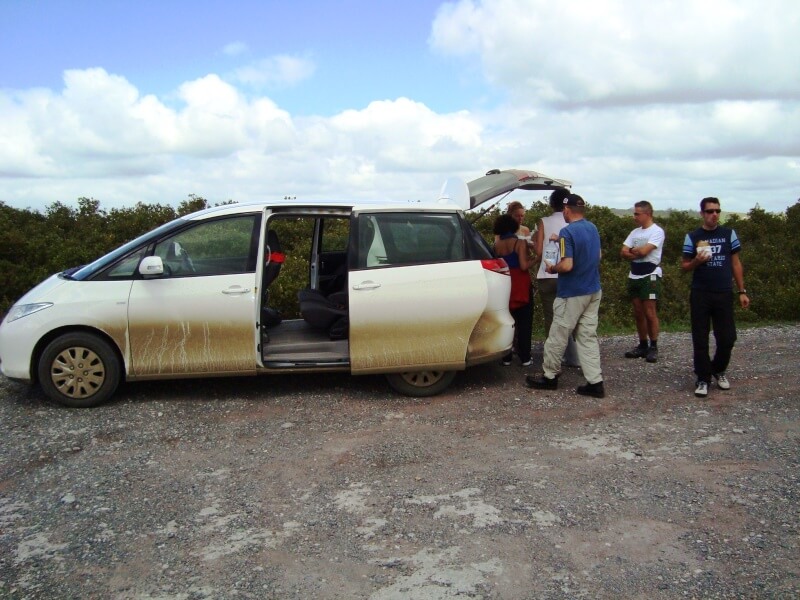






This morning with a boat we reach the islet of Front Beach.
Around the island, I stop in a cemetery on a hill: simple, serene, without sculptures or statues, so far from ours, it gives you the feeling of tranquility and peace ...
Front Beach is famous because the legendary English navigator James Cook landed here in the second half of the 1700s. Unlike the Dutch Abel Tasman, (from which both an Australian sea and an island takes its name), Cook managed, thanks to his diplomatic skills, to establish good relations with the indigenous peoples and slowly conquer this distant island. .
His predecessor, 100 years earlier did not have good luck, the fleet halved following the fighting with the natives, various unsuccessful attempts led to the renunciation of the conquest with the motivation: "The population is riotous and there are no raw materials of particular importance, then it's not worth it ... "
In Waihi we stop for lunch right along the edge of an immense spiral hole in the earth that goes down to 650 meters and we discover to be a gold mine ...
Before reaching our destination today (Rotorua) we stop at Ohinemutu. A large red and white church adorned with Maori statues and drawings immediately catches our attention. The fumes from the sulphurous water wells make the environment even more characteristic ...
Wai-O-Tapu. It is covered with collapsed craters, pools of mud and cold, boiling water and fumaroles. The area's water flows into the Waiotapu stream which flows into the Waikato River. In the stream, due to the presence of chemicals from the numerous hot springs in the area, there are no fish.
Wai-O-Tapu is also the name of New Zealand's most famous geyser.
The path inside the spa park is very suggestive, you are surrounded by pools of water with bubbles that start from the lowest depths and then explode on the surface ...
The "Devil's Bath", a crater with a jagged outline, has a fluorescent green water mirror that looks almost painted ...




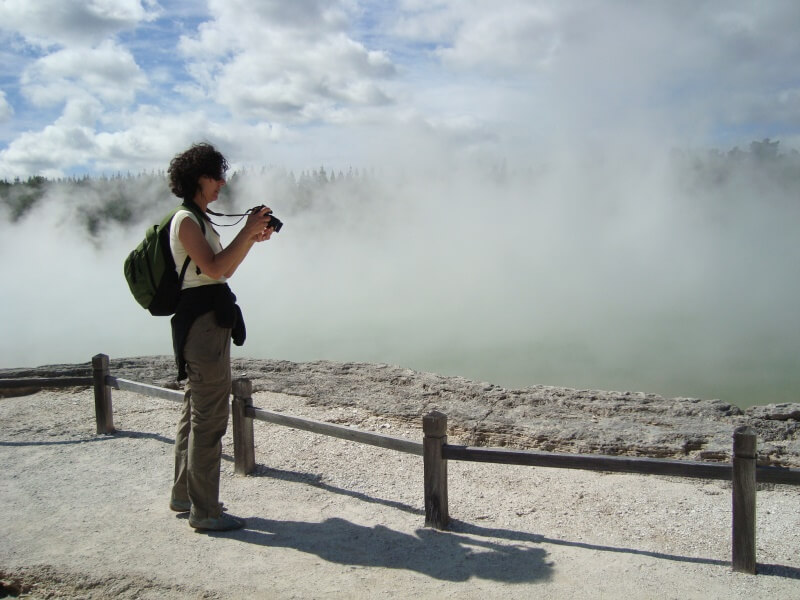


In the late morning we visit the Rotorua museum; The two videos are interesting, one on the history of the city, from when it was inhabited by the indigenous Maori to the advent of the British colonizers, to the beginning of economic gains up to the terrible earthquake of 1886 and to the present day ...
The other video is dedicated to the legendary 28th Maori battalion which in 1939 sailed to England voluntarily to take part in the Great War.
“… 1944 front of Cassino. A New Zealand unit has been attacking a hill defended by the Germans for a week in vain. One morning, at dawn, men come out naked from the trenches and dance a Haka, the ancient dance of the Maori warriors. Chilling screams, hands clapping on mighty thighs, tongues shown to the enemy, eyes wide open. Half an hour later the white flag flies over the German trenches ... "
"Ka mate? Ka mate? Ka now! Tenei te tangata puhuru huru. Nana in the tikis ever. Whakawhiti te ra. A upa ne! A upane kaupane whiti te ra.! " (Am I dying? Am I dying? I live! This is the man with long hair. Who persuaded the sun. And convinced it to shine again. One step up. Another step up. One step up. , another ... the sun is shining ")
"I never thought I would go beyond Franktown Junction and now I am moving about leaving for the other side of the world" (Kuru Waaka)
Tremendous images of those 3500 children who left for those places so far from their wildest imaginations ... 640 never returned to their beloved island; 1200: mutilated. They fought hard in Greece, Egypt, Libya, landed in Taranto to fight in Cassino ...
We leave again, destination: Te Wairoa, a town made famous because it is considered the New Zealand Pompeii.
On 10 June 1886, at dawn, violent and unexpected, there was the eruption of Mount Tarawera, the largest natural disaster in New Zealand. For more than four terrifying hours, rocks, ash and mud bombed the quiet village of Te Wairoa. The eruption destroyed the eighth wonder of the world - the magnificent Pink and White Terraces, and buried everything it encountered under two meters of volcanic material.
Leaving Rotorua we head towards Lake Taupo.
Along the way we stop to buy supplies for the next three days as we will stay for a while into the wild and we take the opportunity to visit a very special zoo: that of the famous kiwis, here, in fact, the animal symbol of this island enchanting is protected and cared for.
Today's shopping was made for tomorrow's trekking. All supplies have been carefully chosen: dehydrated fruit, energy bars, bottles of water for the backpack, sandwiches, etc.
In the afternoon, the ascent to Tongariro National Park begins, where we will stay for the next two or three days, depending on the weather ...
We are in the land of the "Lord of the Rings"!
Mount Tongariro is 1967 meters high and tomorrow, weather permitting, we will climb it covering 19.4 km for nine hours of walking ...
Unfortunately the forecast for tomorrow is very bad, but we will only know at seven in the morning if we can leave for this expedition or not ...
I'm very excited.
It's 10pm and everyone is already asleep, tomorrow the alarm will sound at 5 ...
It's seven in the morning when they give us the okay: you can go ...
We are loaded, fully equipped ...
We leave for the great climb of Mount Tongariro ...
On board an old minibus donated by the Japanese government, Alan comes to pick us up and some other daredevils ... Many try again given yesterday's unsuccessful attempt ...
He makes the latest recommendations, tells us that there is no need to be heroes up there, that if you feel you don't have to do it, you MUST go back as soon as you can ...
We get off the bus and, in the distance, we see a snowy mountain ... Here we go!
The climb begins immediately, I proceed at a brisk pace and, after 45 minutes, I find myself alone ...
The path begins to climb ... An hour passes when I find myself surrounded by snow ... I join two guys from the New Zealand Air Force in training on these mountains, but between one photo and the next I am soon alone again ... We go up again and the cold is felt ... How blessed I have the socks that covered my hands, an idea suggested to me by the Japanese girl at the reception of our lodge ...
I walk alone through a large clearing with many ice sheets ...









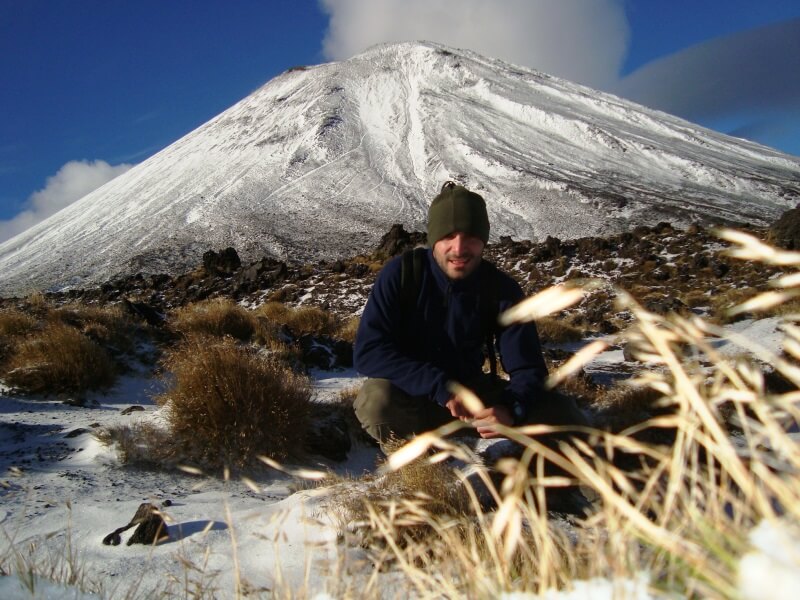



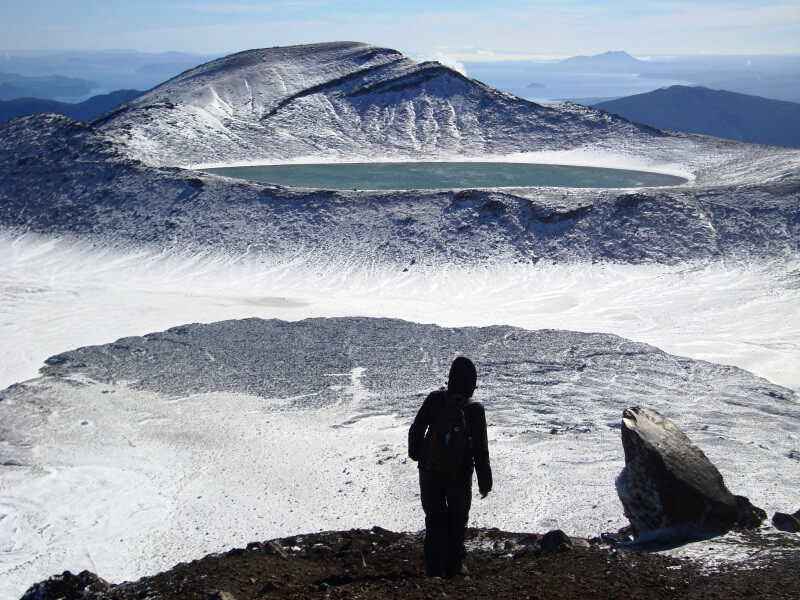

Tania, a 50-year-old from Leipzig (East Germany) joins me, she will be my companion for most of the climb ... The wind begins to blow stronger and stronger, sometimes it seems to push us down, other times to support us ...
Around us only snow, ice, cold ... I smell the scent of the goose feathers of my jacket that shelters my red and chapped face from the cold ...
We climb up giving each other strength ... Suddenly a cry ... Tania screams with joy: we are at the top. 1967 meters. Then she, as a good German, she adds: "Sorry"! I smile and look at the landscape around us… A lake on the right…. Two more in front ... A snowy valley behind and a ravine on the left ...
Mount Ngauruhoe (2287 mt) observes us from above ... Tania points out that there are many clouds that are below us and laughs ... We deeply breathe that pure and fresh air conquered ... Our epic enterprise is only halfway ….
The descent begins: it is more difficult than we thought ... A few steps and I see Tania on the ground ... She gets up but her hand is bleeding profusely ... I offer her the only handkerchief I have and we continue ... Every now and then I offered her a piece of my sesame bar , she some of her chocolate ... We looked like Coppi and Bartali on the Tonale ...
At the third hour of walking we cross a girl from Oregon who came from the opposite direction ... She asks us for information on the part she still had to face and gives us suggestions on what we were missing ... In the meantime, two Swedish girls join us ... They said they could not believe that until a few days ago they were on the beach sunbathing and now they were in the mountains surrounded by snow ...
We proceed, the descent begins to make itself felt, the snow begins to be rarer and my nose aches ...
After three hours and 41 minutes we reach Ketetahi ... The hardest part is gone ...
We sit down, we relax a bit ... The feet in the fresh air to cool off ... I wait for my friends for a packed lunch ... Tania is waiting for her husband ...
As they arrive, we tell each other about our different feelings, we are all satisfied and euphoric ... If the weather had been worse I don't dare think there about how we would have reacted ..
Two sandwiches and I set off on my own ... 45 minutes later the background changes completely ... No more mountains but woods mixed with forest, no more snow but mud, no longer uphill but downhill ...
I am completely alone now ... in the company of the chirping of birds and the flow of the stream that occasionally crosses my path ... The sun is no longer there but big clouds ... I was ready to wear my raincoat but I go straight ...
1 hour, 11' later, I come out into a large clearing ... I arrived ...
What an unforgettable day. 19 km and 400 meters: Over!
In the evening, in front of the lodge's lit fireplace, after having cut my beard, I rest my tired bones and muscles ...
Long day of transfer until arriving in the New Zealand capital! The southernmost capital in the world! In these days I have met people from all over the world, boys and girls who, at some point in their lives, have decided to take a break and discover the world and perhaps even themselves. It is nice to see how the origin determines different needs, there are those who, like the Germans and Austrians, leave before starting university, a break of a few months ... To hell with studying, there is time for that, when they return they will have a life baggage much heavier than that of their peers; Americans and Canadians who do it immediately after university, before fully immersing themselves in the world of work; the nice Israelis who leave after years of compulsory military service to find some peace of mind and recharge ...
Wellington. The capital bought with 9 mirrors, some red hats and 2 hoes from the British to the Maori. He needed a bit of concrete, a bit of traffic, a bit of music from the pubs, a bit of asphalt after all this nature ...
A really bustling city!
The Te Papa museum is confusing, much praised by our Lonely Planet but that if it hadn't been for the Monet exhibition it would have been a bit monotonous ... There is a 4-meter cuttlefish, the largest in the world, caught by a fishing boat for case some time ago ... who knows what is hiding in the abyss ...
Cuba Street on Friday night is a mess, I felt like I was in England on a weekend night ... Same casino, same cold, same gorillas at the entrance of every pub, same line of girls with IDs. in hand to enter, the same guys in short-sleeved shirts and girls in tank tops and miniskirts, the same desire to party ... tomorrow we leave the north island.
It is dawn and we are ready for boarding.
Three hours rocking from Wellington to Picton through breathtaking fjords…
Exciting when, at a certain point, we met a herd of dolphins playing, performing jumps and pirouettes under the admiring and amused eyes of all ...
In Picton we take the two new cars that will take us around the South Island.
We leave for Motueka.
We are close to the Abel Tasman National Park, tomorrow we will do another trek even if my legs and buttocks still hurt ...
Spending a Saturday night in an anonymous and small town in New Zealand, in a pub listening to three rockers playing Blink 182, Radiohead… Together with the local kids dancing and drinking beer… An ordinary village any day… Simply gorgeous!
Early in the morning, on board a motorboat, we fly, wave after wave, to Awaroa while along the way many penguins and seals, spread out in the sun, remind us that we are in the far south of the globe ...
"Beware of manta rays when you get into the water", they suggest when they leave us 50 meters from the shoreline and, in the water, shoes and backpack in hand we conquer the beach ...
We immediately enter a grove. 45 minutes' walk later, a wonderful and unspoiled beach appears before our eyes: Onetahuti Beach… A long strip of golden sand in front of a crystalline sea… I am speechless!
We enjoy the maritime panorama for a while because we still have 15 km to go ... After the beach we enter a dense forest that runs along the sea, many small paths that climb the mountain ... An hour later I find myself alone again ... I'm alone with the nature, silence broken by the rustling of the bushes, by the singing of a thousand different birds ...


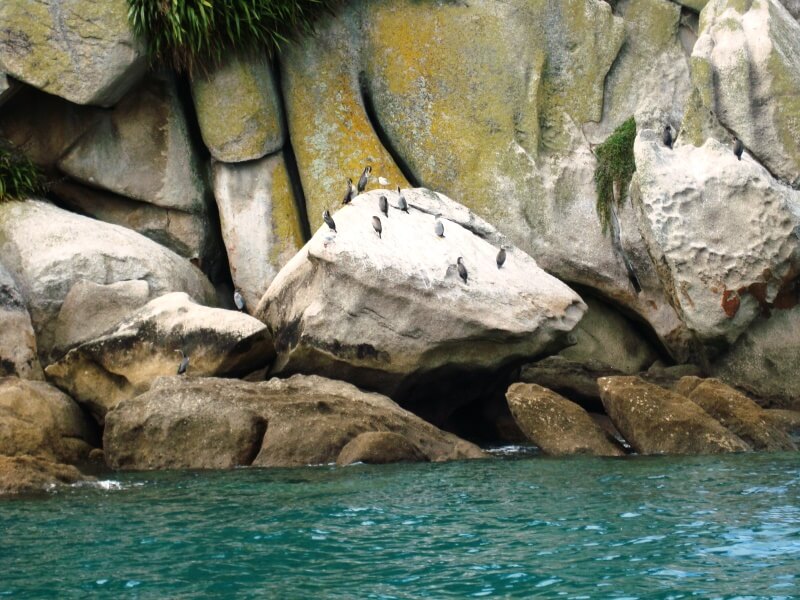



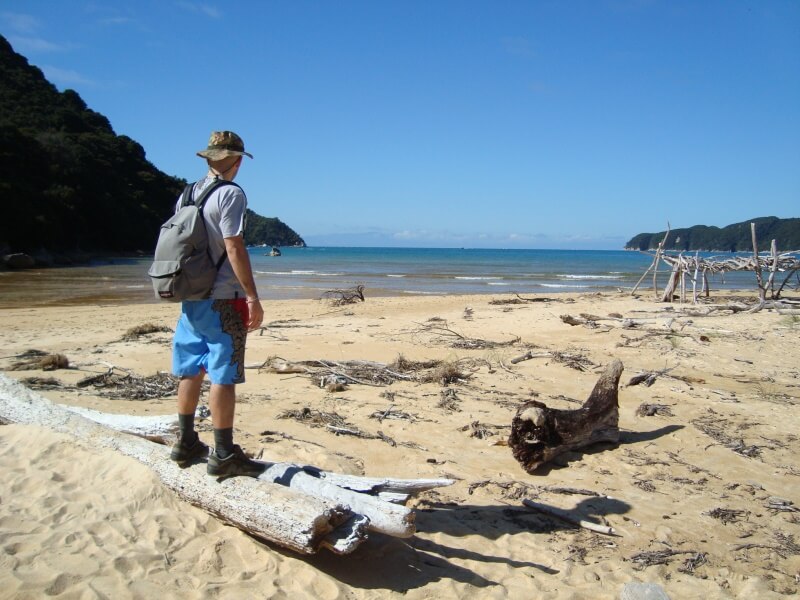



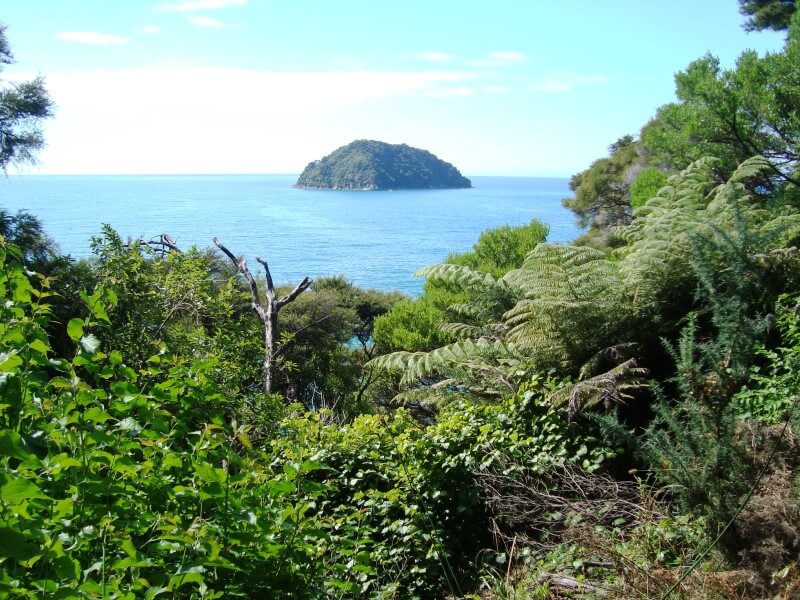



What a feeling of freedom and life ... Two hours and 41 minutes later I reach Bark Bay ... I wait a long time but no news from my friends ...
Through breathtaking landscapes along the coast, I pass a suspension bridge, I go up, I go down, I climb ...
Four hours and three minutes later here is ours: Torrent Bay.
I don't have time to relax a bit when our motorboat arrives to pick us up ... What a day!
We leave Motueko and away 450 km south towards the glaciers!
How many villages did we go through, saw children leaving the house to go to school, proud in their little uniforms, the postman on a bike throwing newspapers at the doors of the houses ...
Now we are in Franz Josef, a village discovered by an Austrian climber and whom he baptized with the name of his king. It is the starting point for climbing the two glaciers, the namesake and the Fox!
Franz Josef Glacier!
After being properly equipped with wool socks, goretex boots, raincoat and crampons for the ice, we cross the bed of a dry river on foot and suddenly the glacier, in all its grandeur and majesty, appears in front of us!
It is white and blue and you feel so small in front of it!
We are 13: seven Italians, four Estonians and two English. We stop at the base and, wearing the crampons, in single file, we begin the climb. You have to put your feet well on the ice, sometimes cling to the rope that our guide-opener fixes in some places. Other times, to facilitate us, he digs small steps with a pickaxe ...
The glacier wraps and surrounds us, we are small blue dots in a white sea ...
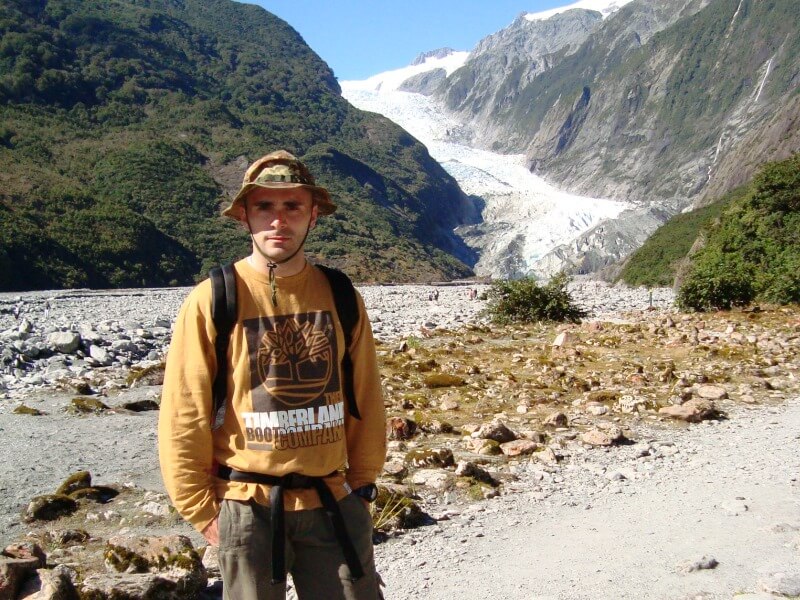





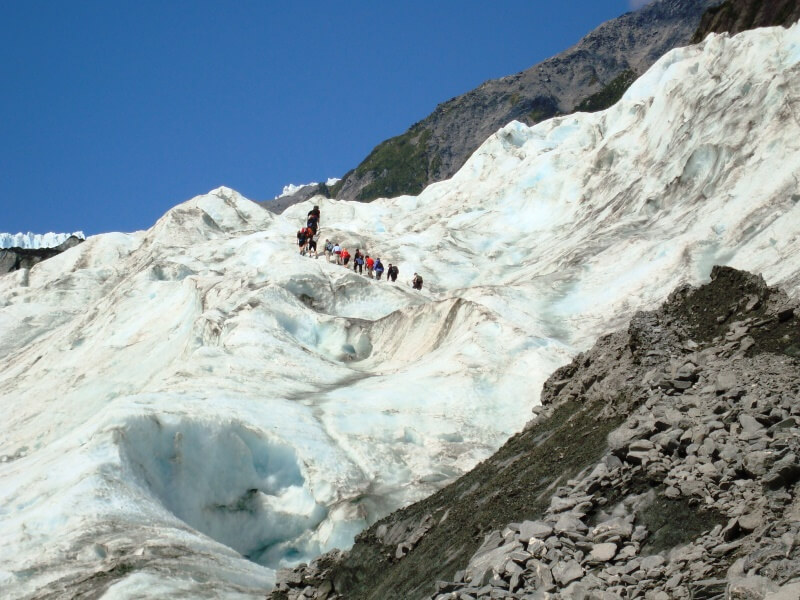



Queenstown is a very touristic city but of a different type of tourism, not made up of backpackers and travelers but of real vacationers ...
This city in the mountains of New Zealand's South Island, where bungee jumping was invented, is a paradise for adventure lovers.
Embraced by Lake Wakatipu, one of the longest in the country, and the peaks of Ben Lomond, the city is one of the most visited destinations in New Zealand.
Dinner at "Captain", a typical restaurant where we taste the delicious New Zealand specialty: "Green mussels". Delicious!
Midford Sound: defined by Kipling as the eighth wonder of the world!
We board a three-story ship ...
These fjords are majestic ... They look like stern big men who, arms folded, look at you seriously from above ...
The clouds coming from the Tasman Sea, arrived here, remain almost trapped by those peaks and consequently it always rains generating thousands of waterfalls everywhere ...
Every now and then we pass by large rocks populated by seals that roll or dive into the water under the amused gaze of all of us ...
We cut the southern island from the west coast to the east one up to Dunedine.
Our destination is Portobello, a meeting with the "yellow eyes" penguins awaits us.
The nice old Dave tells us that there are many species of penguins in the world and that many live in these parts ... We had seen some of them yesterday during the cruise to Midford Sound, but in this kind of farm they have created a real hospital for them. "Elegant" (given the tuxedo) little animals ...
There is the rehabilitation department (for those injured by sharks or seals), pediatrics (for undernourished children) etc.
We follow Dave on the long ride through small trenches built to get as close as possible without disturbing them.
I was struck by the complete harmony of seals, penguins, sheep and seagulls; they all live together in total harmony ... "Every now and then a few sheep get too close to the penguins but a peck is enough and they immediately return to their places"!
Dunedin, nicknamed the "Edinburgh of the South" of New Zealand, is a coastal city that will win you over in all seasons.
The heart of the small center of Dunedin is occupied by the Octagon, a historic square that can be easily explored on foot and full of lively pubs and bars, cozy restaurants with outdoor tables, street performers and stalls. Nearby you can admire other characteristic buildings of the city, such as Speight's Brewery, the City Hall, which is part of the complex called Municipal Chambers, and the elaborate First Church of Otago, while less than 1.2 km away is the University of Otago. With just a five-minute walk from the Octagon, visitors with a sweet tooth will have the chance to visit Cadbury World, New Zealand's largest chocolate factory.
In Moeraki Boulders we stop to admire the large spherical rocks that lie on the beach, like large marbles thrown by a giant ...
There are many Maori legends about the origin of these huge balls weighing tons ... Science explains them with the phenomenon of erosion by wind and water.
Next stop Oamaru. Very nice are the road signs inviting you to pay attention to the crossing of the penguins ... and a little further on there is an infinite colony of "blue penguins", all crowded in a large stadium crowd ...
Last stop: Christchurch.
Famous for its vast green spaces, Christchurch is also called the "Garden City" of New Zealand and offers numerous restaurants, bars, boutiques and opportunities for outdoor sports and adventure.
After the earthquake that hit it in 2011, destroying much of the center and the historic buildings in the neo-Gothic style, the city has been able to reinvent itself. The ancient buildings have been rebuilt and repaired and new complexes have sprung up alongside them which have contributed to giving a new and original face to Christchurch.
The city is easily explored by tram, ferry, bicycle and even on foot. If you decide to use the bicycle, you can freely explore the picturesque banks of the river, taking advantage of the many places to stop for shopping and lunch, browsing the lively open-air markets that animate its streets. The Christchurch Weekly Market takes place every Saturday and showcases the rich local agricultural produce and renowned coffee. In the summer, relax in picturesque scenery on nearby New Brighton beach or join one of the excursions to quaint Lyttelton Harbor.
We stay in the famous "YMCA" and after so many Spartan sleepovers, here is a hotel as it should be ... Comfort, clean towels and sheets, bathroom in the room, I was no longer used to so much "luxury" and I confess that I have not even missed it ...
As I lie down in this comfortable bed I think of yesterday's hostel in Auckland ... Yesterday? No! It was a month ago! Time has flown!
Error: No feed found.
Please go to the Instagram Feed settings page to create a feed.